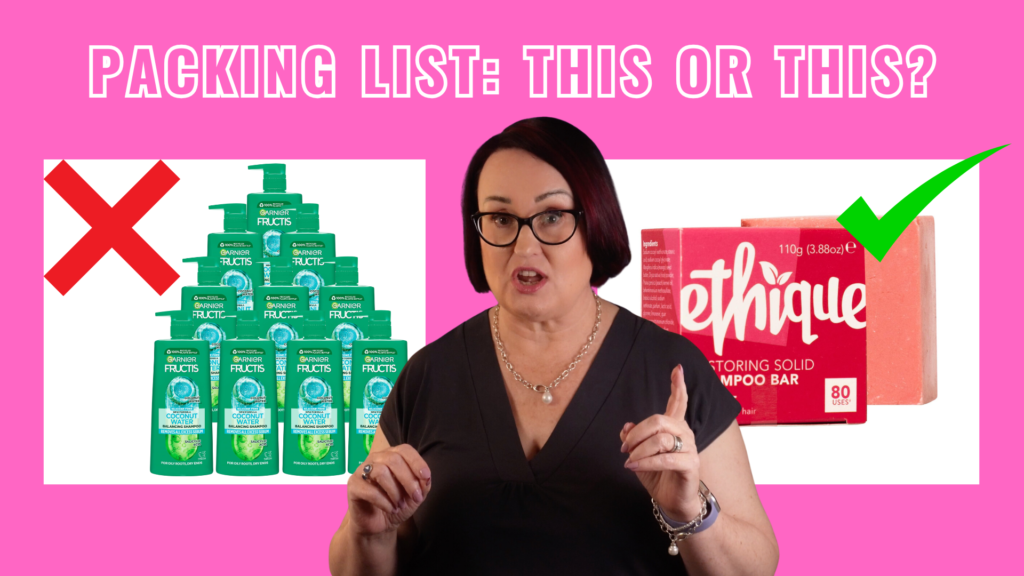LIGHTEN your travel toiletries kit

Are you attempting one bag travel or just wish you could reduce the size of your travel toiletries kit? My travel hacks will help you travel light and minimize your travel size toiletries. No more worrying about the 3-1-1 rule! Now, let me be honest—I’m not someone who travels with just a carry-on bag. I usually check a suitcase. However, over the last couple of years, I’ve been working hard to lighten our luggage, particularly when it comes to toiletries. You might be wondering why I’m so focused on packing light today. Well, we’re gearing up for a six-week adventure in North America and Bermuda! We’re incredibly excited—we’ll be cruising from Montreal to New York, spending two fantastic weeks in New York City, and then enjoying a seven-day round trip cruise to Bermuda before heading back home to Australia. But there’s been a little twist that has influenced our packing strategy—Michael recently had a fall at home! He tripped over a step (nothing spectacular) and ended up dislocating his shoulder and fracturing the humerus in two places. Ouch! He’s recovering after surgery, but since he’ll be in a sling until we depart, we need to keep our luggage light to make things easier for both of us. The bulk of our packing reduction starts with liquids. Most liquids pack a heavy punch due to their high water content. So, I want to pass on the benefits of my research to you! We’ll cover the rules for taking liquids onboard the plane, explore alternatives to liquids, discuss what to leave behind, and finally, how to pack everything effectively. Onboard liquids I’m Australian, but the TSA rules in the USA often come to mind when I think about onboard liquid regulations. Most countries have similar restrictions but remember to check the specific regulations for the country you’re visiting. For instance, the UK has different requirements for the size of clear bags! Leaving Australia on an international flight, the rules relate to powders, liquids, aerosols and gels. I won’t go into details but certain powders, such as washing powder and salt need to be under 350g but don’t have to be packed in a special bag. Liquids, aerosols and gels must be under 100ml and packed in a zip lock bag that measures 80cm or less around the perimeter. All powder, liquid, aerosol and gel products must be taken out at security. You can have one liquids bag per person. Personally, I’ve had good luck getting through without having to pull them out, but it’s always best to follow the packing guidelines just in case. Flying in the USA you have the 3 1 1 rule – each product must be under 3.4 ounces, which is 100ml, be put in a bag that is 1 quart or less (just under a litre) and one bag is allowed per person. I’ve included links in the text above, but I found this information quite easily by searching “flying liquids Australia” and “flying liquids USA” so do the same for the country you’re visiting to ensure that you know what to do. Now, we get to the tricky part—what actually counts as a liquid? Items like mascara and lipstick often cause confusion. A handy tip is to think about whether the product can hold its shape without a container at room temperature. Mascara would definitely be considered a liquid, whereas a lipstick would not—although lip gloss? Yep, that’s a liquid! Don’t forget, there are exemptions for things like medications and baby food, but it’s wise to check the regulations specific to the country you’re visiting. Of course, none of this applies to liquids in checked in bags, but if you are going to travel carry on only you will need to have a really good understanding of the rules! Replacements Why bother with liquids when you can replace them with solid alternatives? Liquid products tend to be heavier, simply because they usually have a higher water content. For example, when I weighed a litre of milk, it clocked in at about one kilo (35.27oz). Meanwhile, the milk powder to make one litre weighed only 130 grams (4.59oz). You can see it by looking at the ingredients list on any product – the ingredients are listed from highest to lowest percentage and the first one is nearly always aqua – that’s water! Take shampoo, for instance. I carry a mini shampoo bar instead of liquid shampoo when I travel. I’ve been using a sample sized bar for six weeks of travel all up, and it’s barely any smaller. I can still see the embossed pattern on it, which tells you just how little has been worn away. If I’d taken liquid shampoo I would have used a fairly large bottle over the same period, and the whole bar must be worth at least ten bottles! There are two more reasons I prefer non-liquid alternatives, and they don’t relate to travel – one is environmental – producing and transporting a shampoo bar instead of ten bottles has a much lower impact on the environment. The second is frugality – it costs a whole lot less for that one bar instead of ten bottles of shampoo! So, at home I use a shampoo bar and toothpaste tablets and plan to replace other items as I run out of the liquid versions. Now, you might have stumbled upon YouTube videos where some travellers have gone completely non-liquid with their toiletries. While I admire that approach, I’ve learned that there are some items I prefer in liquid form—like body lotion, for example. However, even if you switch out just half or a quarter of your products, you’re already making a substantial difference! For my hair care, I use a full-sized Ethique shampoo bar at home. For travel, I have a travel-sized Superzero shampoo bar—thank you, Sephora, for that gift with purchase! I’ve been using the Ethique bar for about 18 months, and I’d estimate it’s just over half used. I
Discovering My Long Flight Essentials: A Comprehensive Guide

Find out what’s in my bag when I pack my long flight essentials. A deep dive into travel gear for 2024. Travel gear essentials brought to you by an experienced traveller! The Importance of Planning for Long-Haul Flights Long-haul flights can range from seven hours to over 17 hours, so having the right onboard kit can greatly enhance your comfort and entertainment during such journeys. I typically categorise my in-flight essentials into six groups, which I’ll cover in detail, and stick around until the end to see how I organise everything at home between trips. This post will delve into everything I bring onboard that I use during the flight. Items I pack for my destination will be saved for another discussion, so if that interests you, let me know in the comments! I’ve written an ebook on long flight essentials – click this image to get your free copy! Travel Outfit Strategy Choosing the right travel outfit is crucial for comfort throughout the journey. My go-to attire consists of merino wool leggings, a merino wool long-sleeved t-shirt, a loose, lightweight dress, a snug cashmere cardigan, and a serape—a versatile garment that’s part scarf, part cape. I complete the outfit with no-show socks and comfortable sneakers, usually my reliable black Nike Air Force Ones. Given that we frequently travel between the southern and northern hemispheres, I find myself adapting to dramatically different climates. While I typically board the plane in the dress, I arrive at my destination dressed in the full outfit, especially if I land in a wintery location like New York. I also keep my winter coat and gloves in my carry-on for easy access. For the flight, I switch into relaxed tracky pants and an oversized t-shirt, ensuring maximum comfort. Before we land, I change back into my travel outfit, helping to prevent any spills or signs of discomfort from remaining on my clothes. During the flight, I prefer to go barefoot and wear thongs (flip-flops) for visits to the toilet, storing them in a separate shoe bag to keep everything else tidy. Health and Comfort Essentials Let’s explore my health and comfort items. I store my prescription medication in a contact lens case for convenience. One side holds a gel I apply nightly, while the other contains my pills. My “just-in-case” medications encompass paracetamol, ibuprofen, a non-drowsy antihistamine, nasal decongestant spray, chewable antacids, and saline nasal spray—essential for combatting dry cabin air that often leads to headaches. Additionally, I carry a small pack of tissues, Hydralyte sachets for hydration, and melatonin gummies and Tylenol PM for sleep. To maintain freshness, I take anti-perspirant deodorant wipes and hand sanitising wipes, which are more compact than liquids. Regarding dental care, I usually rely on Qantas to provide toothbrushes and toothpaste but will pack a travel-sized version if flying with other airlines. I also take compression stockings, though I seldom wear them, as they can sometimes make my feet uncomfortably hot. Watch my ultimate long-haul flight comfort video if you’re interested in more tips to stay comfortable during long travels. Skincare and Beauty Routine Onboard You may have seen in that video that I like to do skincare routines on flights, and I can attest to how refreshing they can be for combating dry air while signalling to my brain that it’s almost sleep time. Before landing, I repeat my morning skincare routine as well. I have a scrunchie handy for my hair, and I use a handheld mirror for quick checks. My nighttime skincare pack includes an oil-based makeup removing wipe, cleansing wipes, hydrating mist, eye cream, and a nourishing moisturiser. For daytime, I use a tinted moisturiser, some blush, an eyebrow pencil, and a subtle lip colour for a fresh appearance upon landing. Given the sensitivities of fellow travellers, I choose to forgo strong perfumes, opting instead for a rollerball when necessary. Tech Essentials for Travel No long haul is complete without technology. My iPad is essential, along with my phone, AirPods, and Bose QuietComfort noise-cancelling headphones for entertainment. I also pack charging gear, including a compact plug-in charger, USB-C cables, and a robust power bank, ensuring that my devices stay powered throughout the journey. I have a silicone neck cord for the AirPods so I don’t lose them in the seat if I fall asleep, and take an Airfly so I can watch the inflight movies using Bluetooth. Miscellaneous Travel Items My miscellaneous essentials include a nail file, glasses cleaning cloth, a pen for immigration documents, and a small jewellery pouch to keep my accessories safe while I sleep. A handheld fan is also a great addition if the cabin gets stuffy. Finally, my passport and wallet are always on the packing list! Packing Strategies for a Long Flight Now, let’s explore how I pack all these essentials. My travel strategy is tailored based on the storage available in the cabin. In economy or premium economy, a spacious sling bag forms my personal item, containing most of my essentials. When I have more space, I utilise four distinct bags to organise my gear efficiently. My first bag is a packing cube for my change of clothes (tracky pants, t-shirt, slippers, compression stockings, etc.), while the second holds my skincare and beauty supplies in a clear liquids bag. For my essential medications and personal items, a small pouch keeps everything handy, and my tech gear fits neatly into another designated tech bag. [soliloquy id=”18222″] Organising Between Trips When I’m not travelling, I maintain an organised system for all my items. Skincare, makeup, and tech gear are stored in boxes specifically designated for travel items, while consumables are rotated in and out as needed. This well-structured organisation ensures that everything stays in order and is ready for the next adventure. Conclusion I hope this detailed guide on my long-haul flight essentials provides you with valuable insights for your future travels. If you enjoyed this post or found it helpful, I’d love to hear your thoughts in the

